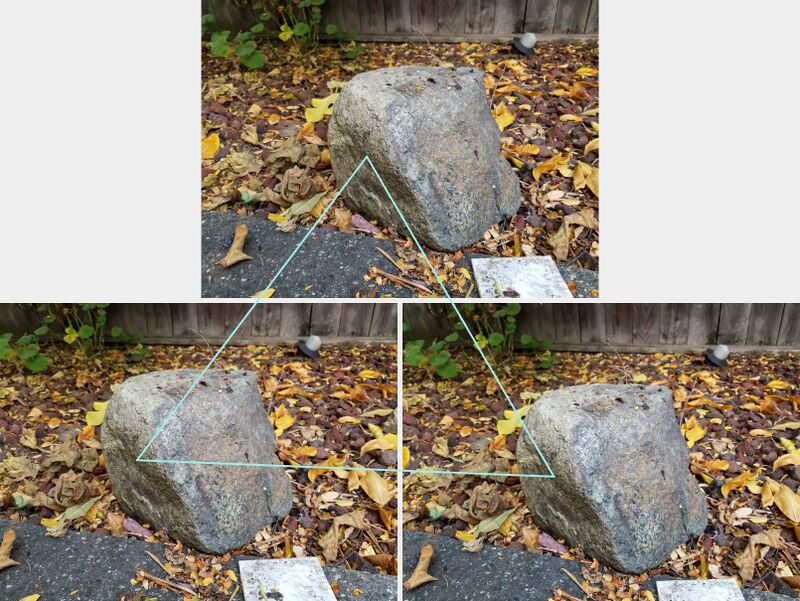Difference between revisions of "Example Associate Three View"
From BoofCV
Jump to navigationJump to search (Created page with "<center> {| | Associated feature between images using example code. |- !Associated feature between images using example code. |} </center>...") |
m |
||
| Line 1: | Line 1: | ||
<center> | <center> | ||
{| | {| | ||
| [[File: | | [[File:Example_three_view_association.jpg|Associated features across three views|800px]] | ||
|- | |- | ||
! | !Three view feature association from using this example. | ||
|} | |} | ||
</center> | </center> | ||
Revision as of 10:34, 12 July 2021

|
| Three view feature association from using this example. |
|---|
Associating features across three views is useful for 3D reconstruction as it produces a more stable solution than 2-views.
Example Code:
Concepts:
- Describe point features
- Associate descriptions
Example Code
/**
* Common matches between sets of three views are important in SFM as they filter out even more false positives
* and three view geometry, unlike two view-geometry, has a unique projection in each image. This makes it even
* easier to remove false matches using geometric constraints. In BoofCV's reconstruction pipeline three views
* are always used over two views whenever possible due to the added robustness.
*
* In this example, association is first done pairwise between each image pair. Then the matches are traversed
* to find features which form a "ring", that is that when traversed from image 1 -> 2 - > 3 -> 1 you wind up
* back at the same location.
*/
public class ExampleAssociateThreeView {
// Stores image pixel coordinate
public final DogArray<Point2D_F64> locations01 = new DogArray<>(Point2D_F64::new);
public final DogArray<Point2D_F64> locations02 = new DogArray<>(Point2D_F64::new);
public final DogArray<Point2D_F64> locations03 = new DogArray<>(Point2D_F64::new);
// Stores the descriptor for each feature
public DogArray<TupleDesc_F64> features01, features02, features03;
// Indicates which "set" a feature belongs in. SURF can be white or black. Using sets simplifies
// feature association since only features in the same set can be matched
public final DogArray_I32 featureSet01 = new DogArray_I32();
public final DogArray_I32 featureSet02 = new DogArray_I32();
public final DogArray_I32 featureSet03 = new DogArray_I32();
// Reference to the feature detector/descriptor
DetectDescribePoint<GrayU8, TupleDesc_F64> detDesc;
// Create lists when accessing by index makes more sense
List<DogArray<Point2D_F64>> listLocations = BoofMiscOps.asList(locations01, locations02, locations03);
List<DogArray_I32> listFeatureSets = BoofMiscOps.asList(featureSet01, featureSet02, featureSet03);
List<DogArray<TupleDesc_F64>> listFeatures;
/**
* Initializes data structures to use the feature descriptor
*/
public<T extends ImageBase<T>> void initialize( DetectDescribePoint<GrayU8, TupleDesc_F64> detDesc ) {
this.detDesc = detDesc;
features01 = UtilFeature.createArray(detDesc, 100);
features02 = UtilFeature.createArray(detDesc, 100);
features03 = UtilFeature.createArray(detDesc, 100);
listFeatures = BoofMiscOps.asList(features01, features02, features03);
}
/**
* Detects and saves features in the specified image
*/
public void detectFeatures( GrayU8 gray, int which ) {
DogArray<Point2D_F64> locations = listLocations.get(which);
DogArray<TupleDesc_F64> features = listFeatures.get(which);
DogArray_I32 featureSet = listFeatureSets.get(which);
detDesc.detect(gray);
for (int i = 0; i < detDesc.getNumberOfFeatures(); i++) {
Point2D_F64 pixel = detDesc.getLocation(i);
locations.grow().setTo(pixel.x, pixel.y);
features.grow().setTo(detDesc.getDescription(i));
featureSet.add(detDesc.getSet(i));
}
}
/**
* BoofCV comes with a class which does all the three view matching for you. Which association and scoring
* function are used is all configurable.
*/
public DogArray<AssociatedTripleIndex> threeViewPairwiseAssociate() {
ScoreAssociation<TupleDesc_F64> scorer =
FactoryAssociation.scoreEuclidean(TupleDesc_F64.class, true);
AssociateDescription<TupleDesc_F64> associate =
FactoryAssociation.greedy(new ConfigAssociateGreedy(true, 0.1), scorer);
var associateThree = new AssociateThreeByPairs<>(associate);
associateThree.initialize(detDesc.getNumberOfSets());
associateThree.setFeaturesA(features01, featureSet01);
associateThree.setFeaturesB(features02, featureSet02);
associateThree.setFeaturesC(features03, featureSet03);
associateThree.associate();
return associateThree.getMatches();
}
public static void main( String[] args ) {
String name = "rock_leaves_";
GrayU8 gray01 = UtilImageIO.loadImage(UtilIO.pathExample("triple/" + name + "01.jpg"), GrayU8.class);
GrayU8 gray02 = UtilImageIO.loadImage(UtilIO.pathExample("triple/" + name + "02.jpg"), GrayU8.class);
GrayU8 gray03 = UtilImageIO.loadImage(UtilIO.pathExample("triple/" + name + "03.jpg"), GrayU8.class);
// Using SURF features. Robust and fairly fast to compute
DetectDescribePoint<GrayU8, TupleDesc_F64> detDesc = FactoryDetectDescribe.surfStable(
new ConfigFastHessian(0, 4, 1000, 1, 9, 4, 2), null, null, GrayU8.class);
ExampleAssociateThreeView example = new ExampleAssociateThreeView();
example.initialize(detDesc);
// Compute and describe features inside the image
example.detectFeatures(gray01, 0);
example.detectFeatures(gray02, 1);
example.detectFeatures(gray03, 2);
System.out.println("features01.size = " + example.features01.size);
System.out.println("features02.size = " + example.features02.size);
System.out.println("features03.size = " + example.features03.size);
// Find features for an association ring across all the views. This removes most false positives.
DogArray<AssociatedTripleIndex> associatedIdx = example.threeViewPairwiseAssociate();
// Convert the matched indexes into AssociatedTriple which contain the actual pixel coordinates
var associated = new DogArray<>(AssociatedTriple::new);
associatedIdx.forEach(p->associated.grow().setTo(
example.locations01.get(p.a), example.locations02.get(p.b), example.locations03.get(p.c)));
System.out.println("Total Matched Triples = " + associated.size);
// Show remaining associations from RANSAC
var triplePanel = new AssociatedTriplePanel();
triplePanel.setImages(
UtilImageIO.loadImage(UtilIO.pathExample("triple/" + name + "01.jpg")),
UtilImageIO.loadImage(UtilIO.pathExample("triple/" + name + "02.jpg")),
UtilImageIO.loadImage(UtilIO.pathExample("triple/" + name + "03.jpg")));
triplePanel.setAssociation(associated.toList());
ShowImages.showWindow(triplePanel, "Associations", true);
}
}